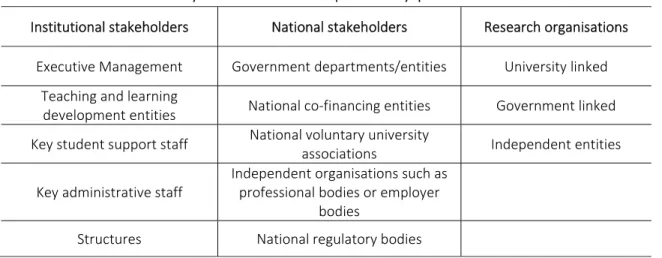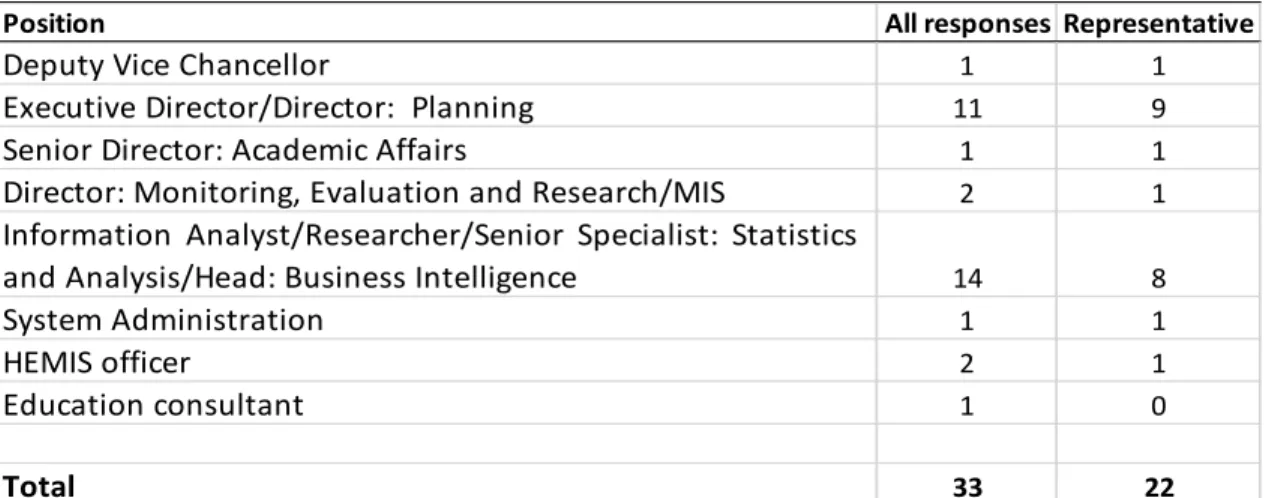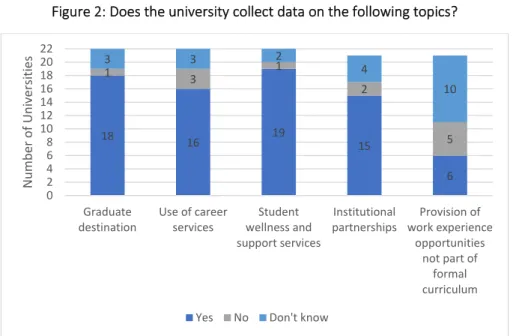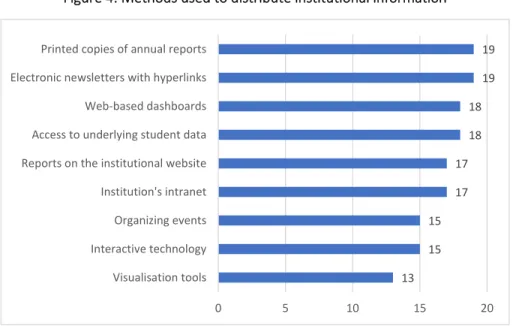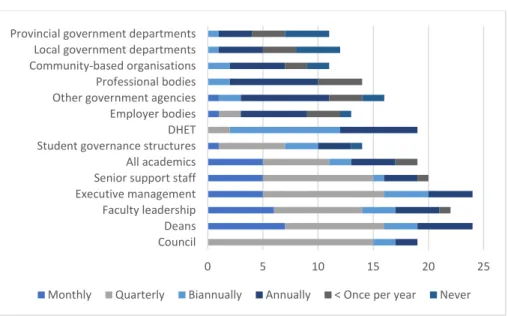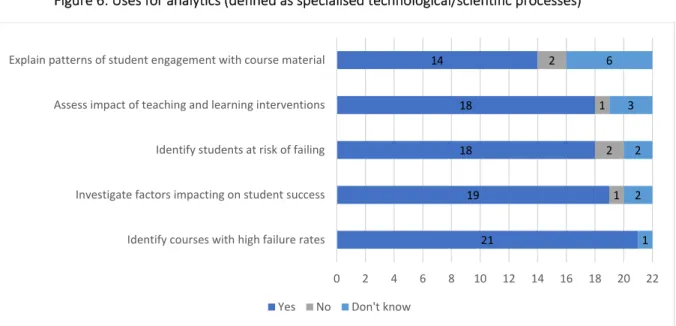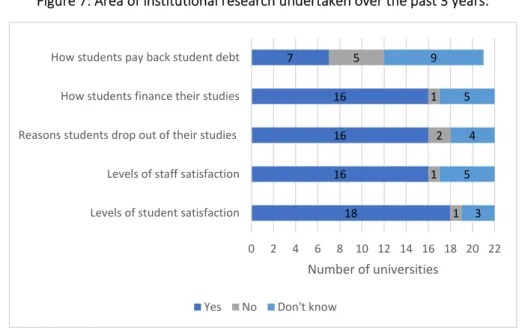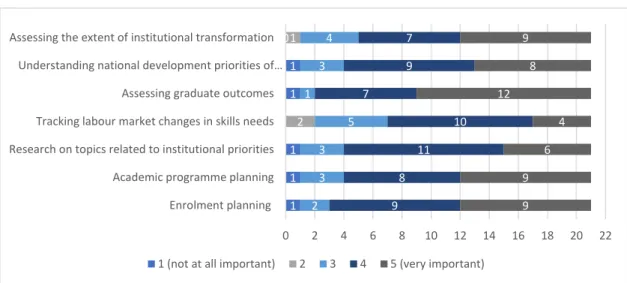This study provides an overview of the status of data collection, analysis, reporting and dissemination at the public universities and public authorities. However, only 12 of the 23 universities responded to the survey, and the three newest universities were excluded (Muller et al., 2016). Siyaphambili's broad aim is to develop a hub for post-secondary education information and research in South Africa that improves understanding of the sector and provides empirical research to inform policy development.
As such, the study began by mapping out who the key stakeholders and potential beneficiaries of the Siyaphambili research would be. Given that the purpose of this study is to describe the information resources generated by central national government departments, statutory bodies and post-secondary institutions in the South African PSET system and to learn how these information resources are accessed and used by various stakeholders, it was decided2 to begin the study by conducting a baseline empirical investigation of information flows within parts of the post-secondary system. The design of the research instruments was based on the adapted version of Terenzini's three levels of institutional intelligence (Terenzini, 2013) described in Section 2.
When compiling the survey instruments, the researchers took into account the Regulations for Reporting for Public Universities3 (DHET, 2014). The survey instruments were reviewed by a virtual working group (see Appendix 2) as well as Mark Cramer (Information Officer at Valsbaai TVET College) and Jan Botha (former Senior Director of Institutional Planning at Stellenbosch University and former president of the Southern African Association for Institutional Research (SAAIR)). In four universities - two new universities, one historically disadvantaged University of Technology and one historically disadvantaged Traditional University - the respondents indicated that they did not know many of the answers.
Two from the Department of Planning, Monitoring and Evaluation (DPME) in the Office of the Presidency.
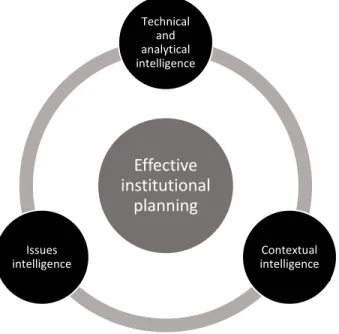
Analysis of the survey results
Overall, three institutions consistently answered 'no' or 'don't know' to four out of five of the questions in this series. This includes one historically disadvantaged Traditional University, one University of Technology and one of the new universities. More than two-thirds of the institutions (15) reported that they produced annual reports on at least six of the nine listed topics, with the average number of reports produced being six.
The reports, ranked by number of 'yes' responses, cover Progress in implementing the institution's strategic plan (21), Transformation (19), Teaching and Learning (19), Admissions (17), Social Responsibility/Community Engagement (16) ), Range and use of career services (11), Range and use of psycho-social support for students (11), Student processing rates for financial aid (12), and curriculum renewal related to decolonization (10) . Significantly, 12 of the 22 institutions indicated that they report annually on the performance of financial aid students. Engagement with stakeholders outside the institution, with the exception of DHET, occurs less frequently.
For example, only seven institutions indicated that they distribute institutional information to provincial government departments within any of the specified time frames. Analysis of the responses to this question in the survey suggests that three universities may not yet have the technological capacity to perform more complex data analyses.6 These include a traditional university, a technological university and one of the new universities. To enable an assessment of the systemic capacity to deliver Tier Two intelligence, questions were also asked about the nature of institutional research undertaken by the universities in the three years prior to the completion of the survey.
Furthermore, eight institutions consistently answered 'no' and 'don't know' to at least three of the five questions about institutional research. Two of the institutions identified as having limited analytical capacity in Figure 6 were also found to have low research output on these topics in the past three years. We do not have enough information to speculate on the reasons for the differences in the nature of the responses.
The responses indicate that monitoring reports are being produced on various aspects of the post-school system. The totals shown in Figure 11 therefore only provide suggestive information about the primary information flows from ministries and government agencies to different target groups. The top three recipients can be categorized as people/entities to whom the report authors are accountable.
It may also indicate that institutional planners are not aware of the reports produced by DHET. Four institutional respondents indicated that they had not read any of the reports, and another four respondents had read only one of the four reports.
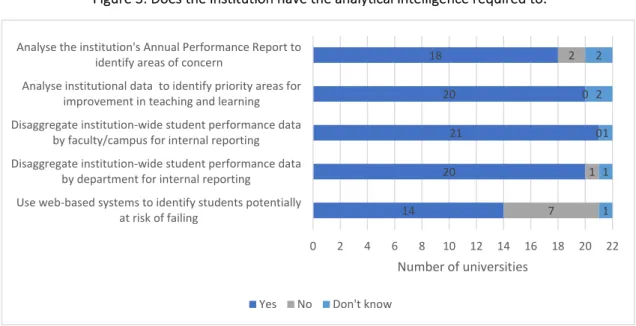
Discussion and Conclusion
The research carried out under the auspices of the Labor Market Intelligence Partnership highlights the importance of moving away from a "focus on central planning mechanisms and structures, it highlights the need to build capacities within organisations, networks and systems to be able to learn and innovate". 2019) suggest that this implies a strong focus on organizational learning within and between organizations that are part of an innovation systems approach. An innovation system analysis provides a useful framework for identifying blockages or absences in the flows of knowledge and resources between post-secondary institutions and public authorities and other actors in the post-secondary space. It also appears that the sharing of information with professional bodies is not perceived to be of critical importance by institutions or public authorities.
This could exacerbate the fragmentation of the post-secondary education system and employers' concerns about the system's lack of responsiveness to employers' needs. Many young people across the country complain about the difficulties in accessing sufficient information about qualification needs, training opportunities and employment opportunities, because the relevant information is available in several places and it requires some knowledge of the different parts of the training and deciding where to must seek information. education system (De Lannoy et al, 2018) This study has highlighted that although there is a certain amount of information sharing, it is not clear how this information is actually used by institutions or public authorities to inform planning. For example, this study has highlighted that the new universities may not have been oriented to the nature of institutional research typically carried out in most of the universities, and this may be due to a lack of participation in SAAIR events.
Finally, it is not clear whether there is an attempt by government or others to raise awareness of the critical resources or sources of information in government and other key agencies that institutional planners should draw upon in their planning processes. The absence of an organized forum where the many actors in the post-secondary system can share intellectual resources generated in different spaces and engage in periodic evidence-based dialogue in order to address any obstacles and respond proactively to ongoing developments within the educational field. , political, economic, social, technological and environmental spheres have been identified by many of the respondents as a significant barrier to building a single, coordinated system. Research into the use of analytics in higher education in the US, UK, Australia and India, and into the strategies governments from forty countries in Africa, Asia, South America, North America and Europe are using to build demand and promote the use of data and evidence in policy making, suggests that context-sensitive strategies are needed to produce content in formats that are relevant and easily accessible to key audiences and stakeholders (Arroway et al., 2016; Avella et al., 2016; Taddese, 2017) .
Evaluating the implementation of the National Qualifications Framework (NQF) Act 67 of What is driving youth unemployment and which interventions are helping. A systematic review of the evidence and a theory of change: High-level Overview Report, University of Cape Town. Ministerial Declaration on the Implementation of the University Capacity Development Program through Effective Management and Utilization of the University Capacity Development Grant.
Regulations for reporting by public institutions of higher education within the meaning of section 41 in conjunction with section 69 of the Higher Education Act 1997 (Act No. 101 of 1997), as amended, Government Notice No. 37726, Official Gazette, June 9, 2014. Deputy Vice-Chancellor Academic/Teaching & Learning Provincial Education Departments Center for Integrated Post-School Education and Training (CIPSET). Deputy Deans: Undergraduate Affairs Office of the Presidency South African Labor Development Research Unit (SALDRU) Institutional University Capacity Development Coordinators Human Resource Development Council (HRDC) ASSOCIATED GOVERNMENT.
Studievejledere Southern African Association of Institutional Research (SAAIR) ADMINISTRATIVE NØGLEPERSONALE South African College Principals' Organisation (SACPO). Jean Skene, Department of Higher Education and Training (DHET) Jennie Glennie, Southern African Institute of Distance Education (Saide) Suellen Shay, University of Cape Town (UCT).
